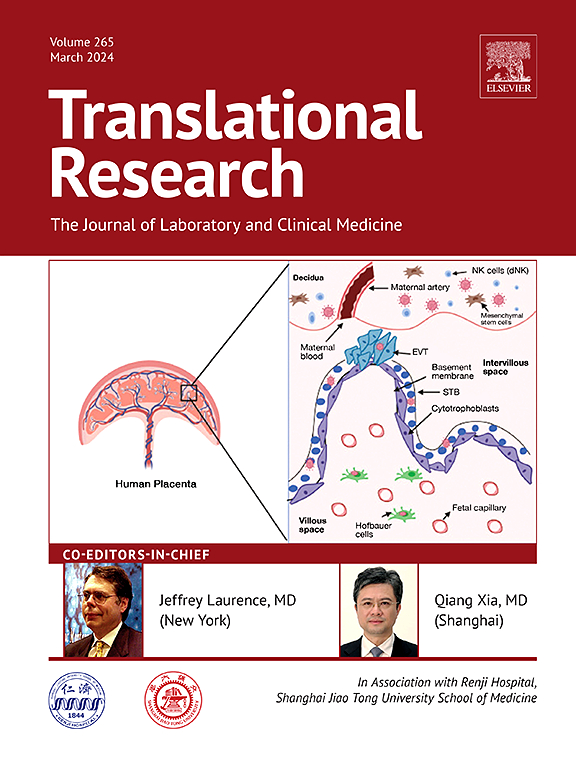tiRNA-HAR contributes to ischemic myocardial injury via facilitating HuR-mediated stability of p53
IF 5.9
2区 医学
Q1 MEDICAL LABORATORY TECHNOLOGY
引用次数: 0
Abstract
Cardiomyocyte death due to heart occlusion of coronary artery is the main driver to myocardial infarction (MI) and subsequent heart failure progression. tsRNA, a small RNA fragment from tRNA, has been shown to be implicated in many physiological and pathological processes by exerting different biological functions, but the roles of tsRNA in ischemic cardiac injury remain to be determined. The present study identified a hypoxia responsive-tiRNA (tiRNA-HAR) was markedly upregulated in ischemic mouse myocardium and hypoxic cardiomyocytes, respectively. Enforced expression of tiRNA-HAR by transfecting its mimic caused and aggravated, while knockdown of tiRNA-HAR mitigated cardiomyocyte apoptosis upon hypoxia. Cardiac specific knockdown of tiRNA-HAR mediated by AAV9 (adeno-associated virus 9) harboring an antisense oligonucleotide reduced cardiomyocytes apoptosis and improved cardiac function after MI. Mechanistically, tiRNA-HAR directly bound to HuR and enhanced the binding capacity of HuR and p53, thereby increasing the stability of p53. Silencing of HuR partially reversed the aggravative effects of tiRNA-HAR overexpression on cardiomyocyte apoptosis in the context of hypoxia. Collectively, our study reveals that tiRNA-HAR play a critical role in regulating cardiomyocytes apoptosis and cardiac injury via targeting HuR/p53 signaling axis after MI, and tiRNA-HAR might be a novel therapeutic target for treatment of ischemic heart disease.
tiRNA-HAR通过促进hr介导的p53稳定性参与缺血性心肌损伤
冠状动脉心脏闭塞引起的心肌细胞死亡是心肌梗死(MI)和随后的心力衰竭进展的主要驱动因素。tsRNA是来自tRNA的一个小RNA片段,已被证明通过发挥不同的生物学功能参与许多生理和病理过程,但tsRNA在缺血性心脏损伤中的作用仍有待确定。本研究发现缺氧反应性的tirna (tiRNA-HAR)分别在缺血小鼠心肌和缺氧心肌细胞中显著上调。通过转染tiRNA-HAR模拟物,增强tiRNA-HAR的表达可引起并加重心肌细胞缺氧后的凋亡,而tiRNA-HAR的敲低可减轻心肌细胞缺氧后的凋亡。含有反义寡核苷酸的腺相关病毒9 (AAV9)介导的心脏特异性敲低tiRNA-HAR可减少心肌细胞凋亡,改善心肌功能。在机制上,tiRNA-HAR可直接与HuR结合,增强HuR与p53的结合能力,从而提高p53的稳定性。在缺氧环境下,HuR的沉默部分逆转了tiRNA-HAR过表达对心肌细胞凋亡的加重作用。综上所述,我们的研究表明,tiRNA-HAR在心肌梗死后通过靶向HuR/p53信号轴调控心肌细胞凋亡和心脏损伤中发挥了关键作用,tiRNA-HAR可能成为治疗缺血性心脏病的新靶点。
本文章由计算机程序翻译,如有差异,请以英文原文为准。
求助全文
约1分钟内获得全文
求助全文
来源期刊

Translational Research
医学-医学:内科
CiteScore
15.70
自引率
0.00%
发文量
195
审稿时长
14 days
期刊介绍:
Translational Research (formerly The Journal of Laboratory and Clinical Medicine) delivers original investigations in the broad fields of laboratory, clinical, and public health research. Published monthly since 1915, it keeps readers up-to-date on significant biomedical research from all subspecialties of medicine.
 求助内容:
求助内容: 应助结果提醒方式:
应助结果提醒方式:


